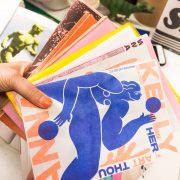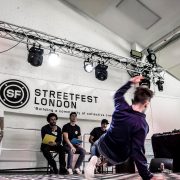Red Bull Music Festival 2019 in Review

This summer, Red Bull Music Festival took to London for a series of live performances, panel talks, immersive workshops and installations all in celebration of London’s iconic music scene; both upcoming and well established artists. Following hugely successful festivals in New York, Tokyo and Sau Paulo, Red Bull turned the spotlight upon London for the four-week long festival.
One of the main events across the festival was Red Bull’s annual presence at Notting Hill Carnival, in which they teamed up with London’s longest running Mas band Mangrove – offering a mix of the classic dancehall and Soca sounds that represent carnival. Check out the full feature of this weekend here.
GUAP was invited down to the experience the festival, see the highlights below.
A Conversation with Spice @ Subterania
One of the first events of the festival was an insight into the life of the global dancehall superstar, Spice. Grace Hamilton was born in St Catherine, Jamaica and spent her in North London, before returning to Jamaica to pursue her music career.
Dancehall is already a genre dominated by male artists, one of the elements which launched Spice to success was her iconic energy as a live performer. Having performed at the Red Bull 2017 Notting Hill Carnival stage – as well as this years Red Bull Sound System – Spice has asserted herself as a reigning queen of dancehall. Her legacy goes beyond her music – she recently launched the Grace Hamilton Women Empowerment Foundation – a project which undertakes programs aiming to enrich women through business and entrepreneurship.
The event was hosted by 1Xtra DJ Sian Anderson at Subterania, in West London. and in conversation they unpacked multiple aspects of her experience as an artist. Ranging from her appearance on VH1’s Love and & Hip Hop: Atlanta, to her experiences of sexism in the music industry. The event proved to be a really introspective insight into the life of Grace Hamilton – and her musical alter ego – Spice.

Source: Red Bull Content Pool 
Source: Red Bull Content Pool 
Source: Red Bull Content Pool 

Bass, Mids, Tops: A Conversation on Sound System @ Red Bull Studios
On the 22nd September, the Bass, Mids, Tops exhibition was launched bringing to life the new journalist Joe Muggs’ and photographer Brain David Stephens new book: ‘Bass, Mids, Tops: An Oral History Of Sound System Culture’. The exhibition was open for free till the 8th September. The book itself traces the timeline of the bassline through UK music history, unpacking; from reggae to dubstep, and many sub-genres in-between.
On the 4th September, Red Bull hosted Bass, Mids, Tops live – a conversation led by Joe Muggs himself, in discussion of the impact of the Sound System and it’s impact upon the UK Music scene. The talk featured notable names within the industry, including Mykaell Riler – founder of the Bass Culture Expo 2018 (check out the feature on GUAP here), Shy One – one of London’s most versatile DJ’s and producers, Cooly G – artist, producer and selector, and Noodles – musician and guitarist.
The talk delved into the history of the bass line, tracking the way in which it has evolved into an abundance of sub-genres, sounds and cultures, both in nationally and internationally. All of which arguably stem from the international influence of reggae. I spoke to Joe Muggs, to unpack this topic further, as well as understand his inspiration behind the book.

Source: Red Bull Content Pool 
Source: Red Bull Content Pool 
Source: Red Bull Content Pool 
Source: Red Bull Content Pool 
Source: Red Bull Content Pool
What was your introduction to Sound System Culture, and why do you think it has had such a huge impact upon the UK music scene?
“So my dad was on a cricket team, and we lived in the countryside – miles from any Sound Systems. He had a cricket team called the Edgy Cricket Allstars. He would play Sunday cricket in a park in Reading, and there were lots of Caribbean and Asian people on the other teams. And they were old hippies so they smoked. My dad would invite all his cricket friends over and listen to music on this brushed steel, 80s hifi speaker – I was young at the time, so as a kid it was like standing next to a proper, huge, sound system speaker. So when all his mates would cover over, suddenly the speakers got a bit louder, and bass got turned up. They’re all extra relaxed, and enjoying it a little more. I realised that the same music I heard in the car, sounds different on this big speaker.
That’s what the book’s about – that’s what I’ve made this research project about. I know why I love standing next to massive speakers, whether it’s with a beer or off my tits in the 90s. Those bass vibrations and those particular reggae samples, the familiar licks of hip hop and reggae just speak to me. I mean, one – they have the instant effect of shaking your body up, making you feel good and it’s doing the same to everyone around you. But two – it’s slightly unifying and all those cheesy thing, it’s a shared experience.
But these records – red grove and jungle, broken beat and garage, really paint a picture (in those fragments of different influences that form them) of the country at its best – as I recognise it. This really squeezed together, small island where cultures merge, not necessarily getting on, but, at least finding common ground through music. This musical thread has given me this hopeful feeling that however stupid and wrongheaded we might be, we at least created this thing together.”
How aware do you think the consumers of these contemporary sub-genres are of their historical predecessors, and roots?
“So, you’ve got two things. Firstly, the ravers – the hardcore, the party people, the passionate music fans – who have tended to always have a sense of what came before. And then you’ve got the inherited musical influences, a generation who have adopted learnt from their They’ve learnt from hanging out at sound system parties, going to family BBQ’s. Within sound system culture itself there’s a natural habit of handing influence stuff through intergenerations.
You would go to barbecues and hear the old school records. Like, every dancehall fan knows Murder She Wrote. It’s a record that came out in 1992. Any DJ will pull that out at a party, or you’ll hear bits of it sampled on a track, and instantly recognise it.
Right now actually there’s a few records that really make me realises how it’s coming back around. Strike A Pose, Simmer and OT Bop all have that distinct old school dancehall vibe, they have a bit of Neptunes. Simmer even samples Beanie Man. These bits that people recognise from their parents or grandparents, almost instinctively.
The more things such as the Saatchi rave exhibition, Mykaell Riley’s project at Westminster University, and hopefully this book – the more the general population will understand that this is our culture. And it’s equally, an important part of our culture.“
What role does Notting Hill Carnival play in the evolution/lifeline of Sound System culture?
“Notting Hill is huge, and it’s special, not just for the UK but for the whole planet. It’s vital, it’s a huge showcase in the same way that Glastonbury and Coachella are – and it should be celebrated as such as the global media.”
How do you self-position yourself when writing/researching topics that often can be found in working class communities, communities of colour, LGBTQI+?
“I’m constantly trying not to be that white guy explaining culture – cause there’s an awful lot of them about. In my job you always have to strike a balance between using your privilege to share the things your exposed, whilst understanding whether/how much you are filtering it through your own perspective. And also try and just big up as many of the actual voices.
That’s what this book is about actually, it’s about the people that were actually there – with their feet on the ground, hands on the turntables – the people who are far more important to the culture than I could be. It’s about 25 people, their life stories, and their voices.
I also just want to say how important it’s been to me to read people telling the same stories from intersecting sides. For example, Simon Reynolds’ Energy Flash – traces the same lineage but in a specific rave-orientated way, or Lloyd Bradley, who wrote Bass Culture and Sounds Like London: both specifically about the Black British experience. It’s important to know that this story can be told from a different angle.“
You can find Joe Muggs’ book here.
Coded Language @ The British Library
On the 6th September, Red Bull took their festival to The British Library, for Coded Language. This event took the form of a discussion, celebrating the prevalence of Multicultural London English (MLE). More specifically, unpacking the variety of voices within London’s dialects. The evening, hosted by Kieran Yates, featured Wretch 32, AM (Skengdo & AM) and Bridget Minamore, as well as performances from Kenny Allstar and James Massiah. Kieran Yates led an intuitive conversation unpacking how migration, diversification of communities and new forms of music all manifest to form Multicultural London English.
The British Library is the largest national library in the world, and an institution founded in 1753. Literature in Britain itself is dominated by white, (often male) authors, with only 6.5% of books published in the UK from 2006-2016, being authors of colour [1].
The discussions of the intersections within British dialect, within this context, were something incredible to see. Hearing Giggs’ Talkin’ Da Hardest (the people’s National Anthem) echo in the marble entrance hall of this historically colonial, white institution was a perfect representation of Britain in a post-Empire context. Coded Language delved into the language which encompasses the way we tell our stories, and the places we find home.

Source: Red Bull Content Pool 
Source: Red Bull Content Pool 
Source: Red Bull Content Pool 
Source: Red Bull Content Pool 
Source: Red Bull Content Pool 
Source: Red Bull Content Pool
W10 NiNE8 Collective: No Place Like Home live @ Westbank Studios
On the 7th September, West London’s NiNE8 collective took over Westbank Studios for a series of events and live performances. The music collective hosted a series of workshops including screenprinting, spray-painting and drawing led by collective member Lava La Rue and Charlie Crockett. Followed by a talk and live performance by crew members themselves.
NiNE8 features musicians, rappers, artists and other creatives including Biig Piig, Bone Slim, kxrn, Lava La Rue, Libs, Lorenzo, Mac Wetha, Nayanza IZ and Nige. The talk took us on a tour of West London, through NiNE8’s perspective. Whilst also discussing their unique approach to incorporating various art mediums within their music.
The talk emphasised how important building your own ‘scene’, musically or otherwise, can be so empowering to creatives. Later in the evening, NiNE8 took to the stage for a high energy mix of each artist’s sound.

Source: Red Bull Content Pool 
Source: Red Bull Content Pool 
Source: Red Bull Content Pool 
Source: Red Bull Content Pool 
Source: Red Bull Content Pool 
Source: Red Bull Content Pool 
Source: Red Bull Content Pool 
Source: Red Bull Content Pool 
Source: Red Bull Content Pool 
Source: Red Bull Content Pool 
Source: Red Bull Content Pool 
Source: Red Bull Content Pool 
Source: Red Bull Content Pool
Normal Not Novelty: Hyperdub Takeover @ Red Bull Studios
Normal Not Novelty made its second appearance at Red Bull Festival with Hyperdub Takeover. The first Normal Not Novelty hosted a series of Carnival themed DJ, production and engineering workshops aimed for female and female-identifying musicians.
Normal Not Novelty: Hyperdub Takeover focused upon the many sub-genre’s of global bass music. Returning collaborator Cooly G was joined by Loraine James and Lady Lykez for an evening full music of relaxed, and inclusive music education (and of course Red Bull).
Normal Not Novelty is a monthly music production workshop hosted at Red Bull Studios – accessible to all female and female-identifying musicians. Check it out here for further details.
Shy One & Victoria Sin: We Know That We Can Shape Ourselves @ Hoxton Docks
The penultimate event of Red Bull Music Festival was We Know That We Can Shape Ourselves – brought together by DJ/producer Shy One and performance and drag artist Victoria Sin. The two collaborators were joined by London’s iconic queer collectives BBZ and Pxssy Palace – as well as artists Xana and Last Yearz Interesting Negro. The evening highlighted the borders at which art and QTIPOC club culture merge – for an inclusive exploration of space and identity.
Xana opened the show, with an incredible performance of her freestyled poetic rap, over her own live-loop – created on stage. Following Xana, Last Yearz Interesting Negro took to the stage for a unique, contemporary movement art piece. Next up Victoria Sin took to the stage for a truly mesmerising drag performance. Sin reflected upon the systems of power in place, from the perspective of the emotional and physical experience living in a material queer body. The evening was cut with a variety of DJ sets from Shy One, BBZ and Pxssy Palace.
As Red Bull states: the evening was a ‘celebration of the spaces and people who are making their own worlds in a world which is not made for them.’ [2] We Know That We Can Shape Ourselves was a night whereby queer womxn, non-binary and transgender communities of colour were put centre stage, in an abundant and unapologetic celebration of themselves.

Source: Red Bull Content Pool 
Source: Red Bull Content Pool 
Source: Red Bull Content Pool 
Source: Red Bull Content Pool 
Source: Red Bull Content Pool 
Source: Red Bull Content Pool




![ZINO VINCI’S ‘FILTHY & DISGUSTING’EP BRINGS YOU TO THE CORE OF THE ARTIST [@ZinoVinci]](https://guap.co/wp-content/uploads/2023/10/Zino-4.jpg)















































